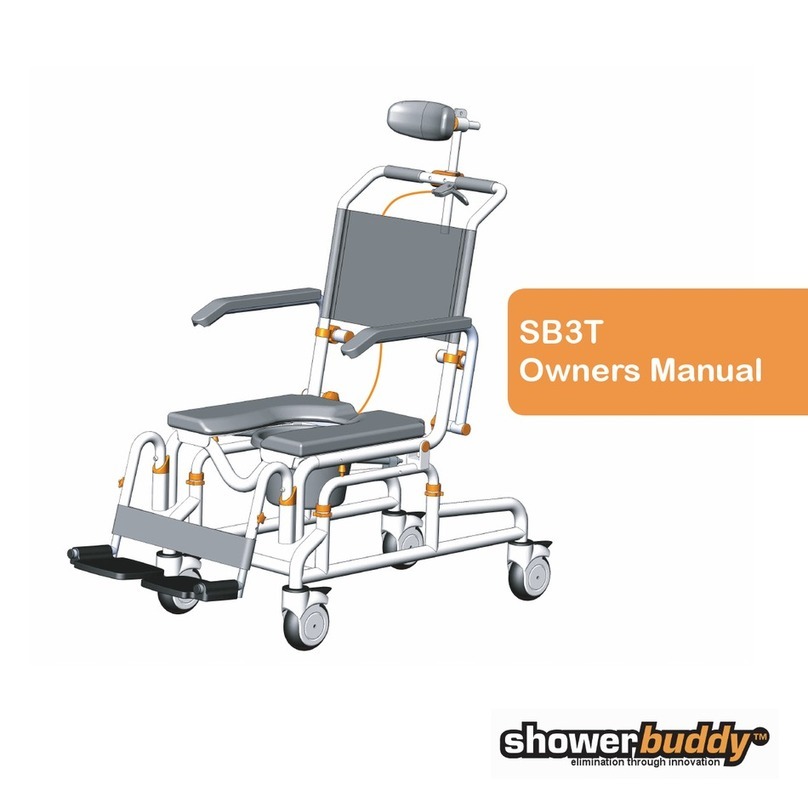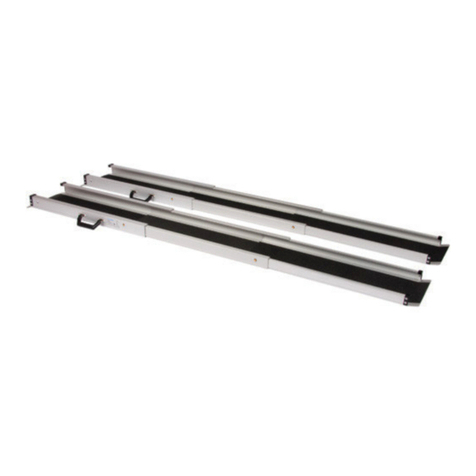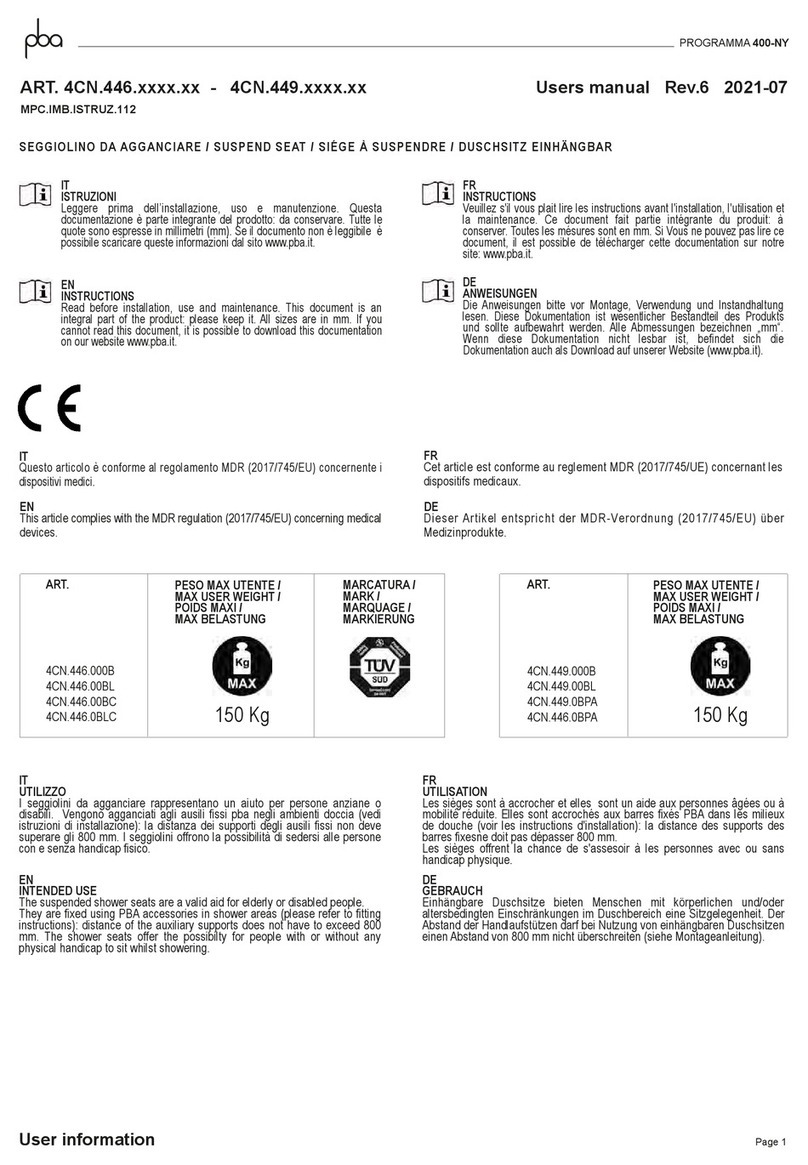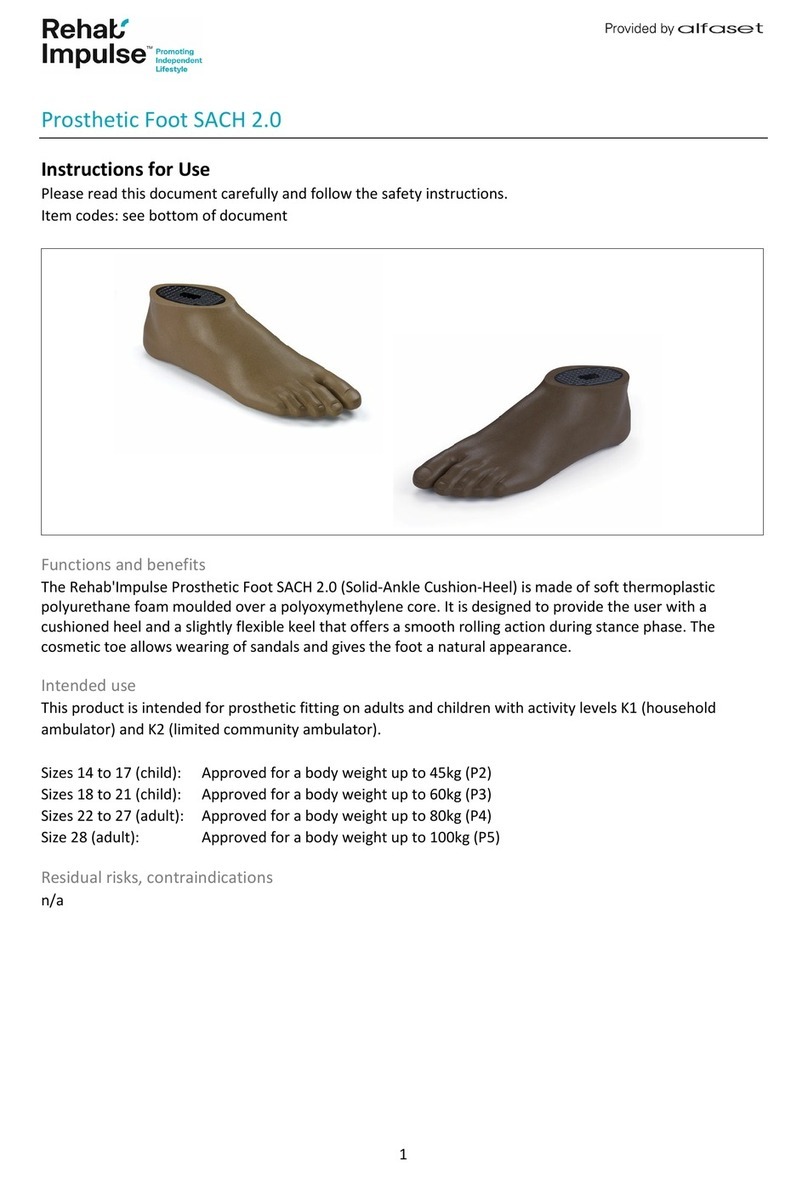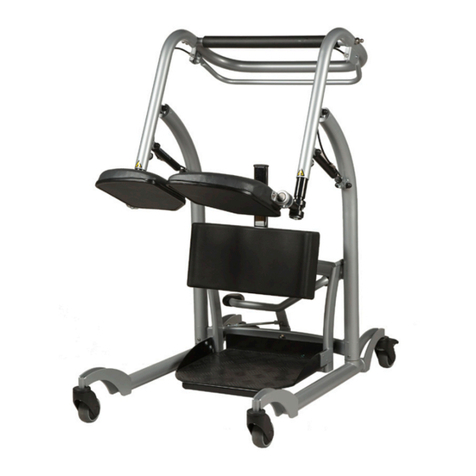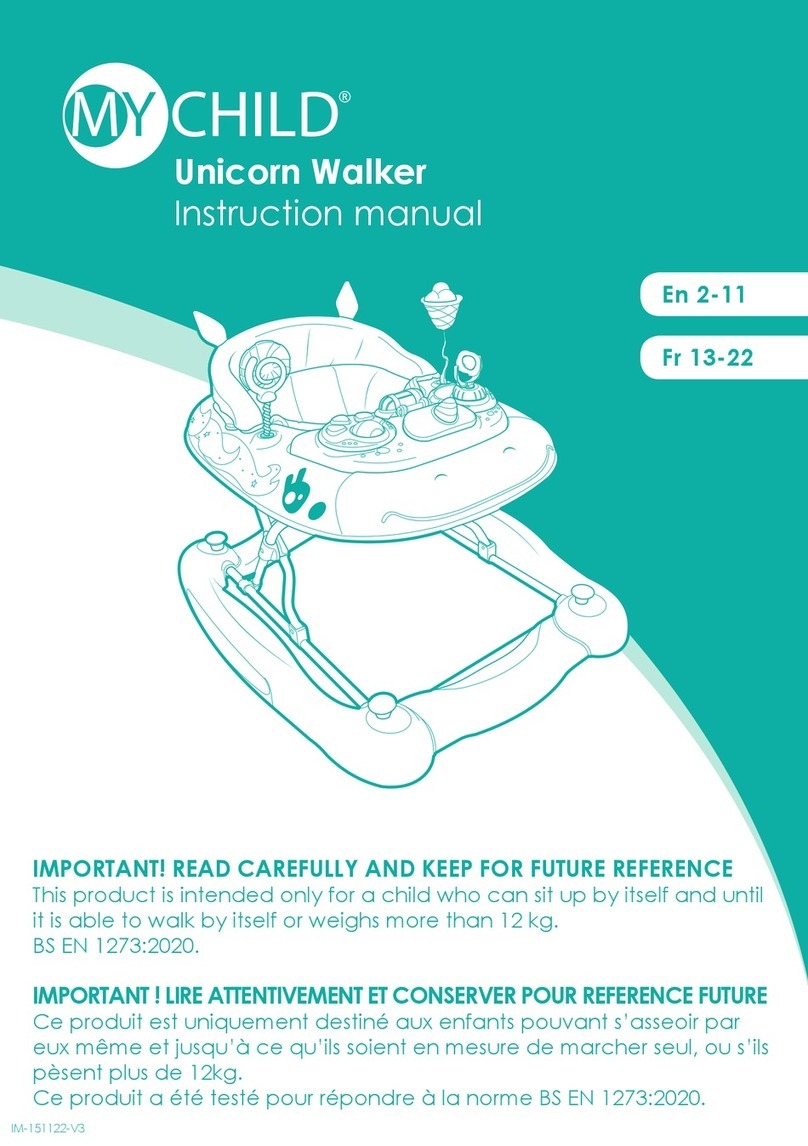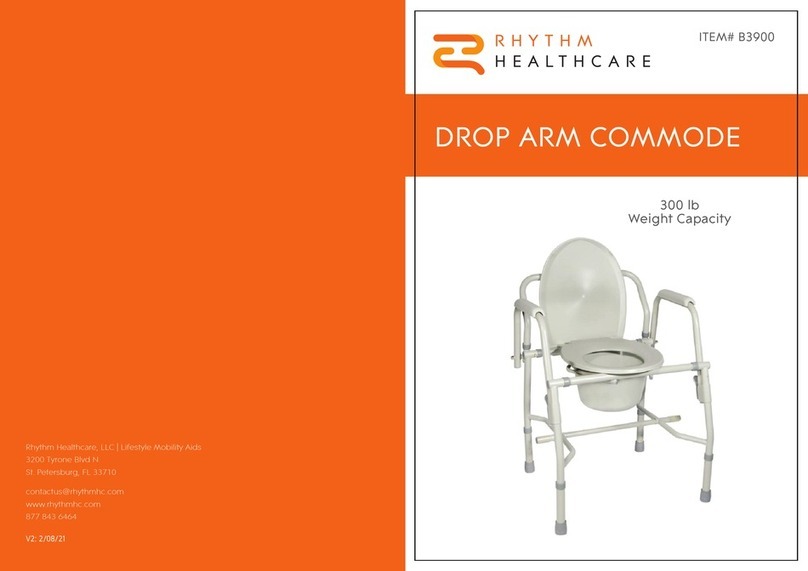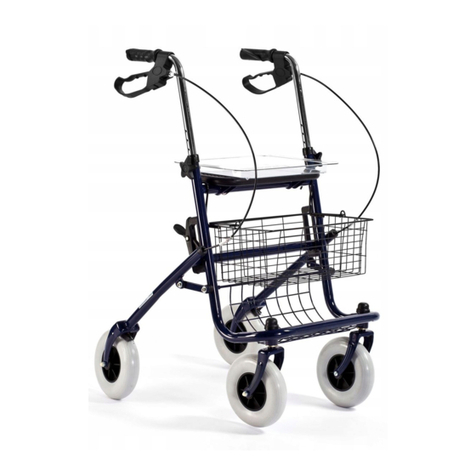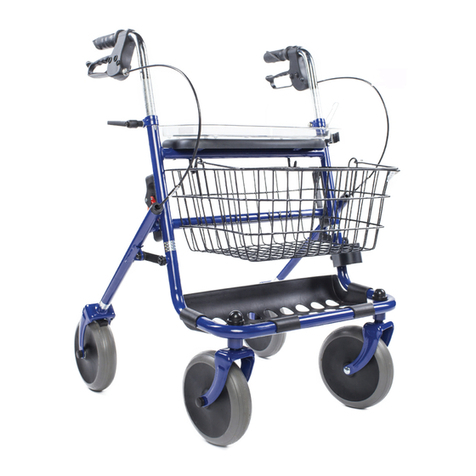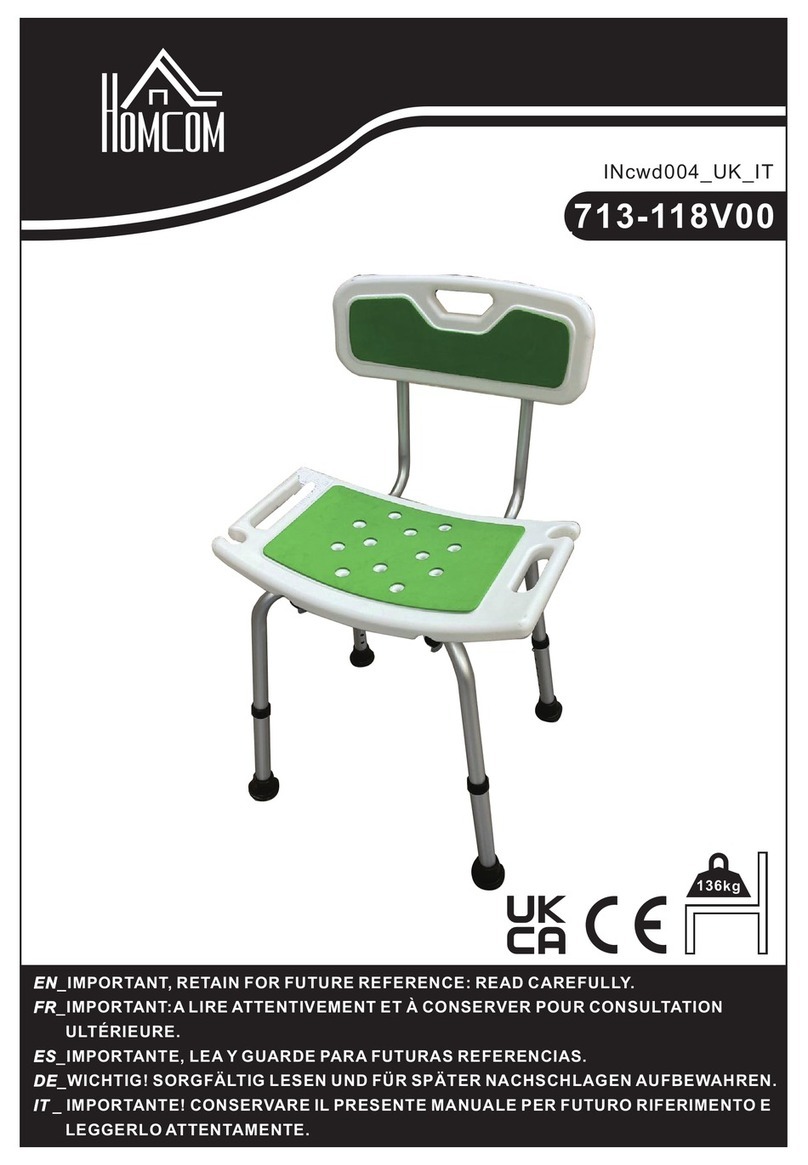Showerbuddy SB3T User manual

elimination through innovation
SB3T
Roll-Inbuddy + Tilt
Owners Manual
page0_SB3T_owners_manual_front_cover.indd 1 24/11/2009 1:32:47 p.m.

page1_SB3T_owners_manual_blank1.indd 2 24/11/2009 1:34:53 p.m.

contents
page 2
Exploded Parts ............................................................... 3
Parts List ........................................................................ 4
Securing Clip Sizes ......................................................... 4
Roll-InBuddy + Tilt Assembly .......................................... 5
Roll-InBuddy + Tilt Operation .......................................... 13
Cleaning + Maintenance ................................................. 16
Safety Instructions ......................................................... 17
Warranty Information ...................................................... 20
Registration Form ........................................................... 22
SB3T Roll-InBuddy + Tilt
page2_SB3T_owners_manual_contents.indd 2 24/11/2009 1:36:52 p.m.

exploded parts
page 3
8
14
18
21
22
23
10
1
2
3
9
7
12
11
13
5
4
6
15
17 16
19
20
SB3T Roll-InBuddy + Tilt
page3_SB3T_owners_manual_exploded_parts.indd 2 24/11/2009 1:38:41 p.m.

parts list
page 4
15” Castor Wheel
2Height Adjustment Tube
Base Legs
3
Securing Clip (Large)4
Back Rest5
Seat Base6
Arm Rest (Right)
7
Arm Rest (Left)8
Arm Rest Knob9
Arm Rest Clip10
11 Arm Rest Lock
12 Cushion
Cushion Connector
13
Neck Rest Height Adjustment Tube14
15 Neck Rest Attachment
16 Neck Rest Handle
Neck Rest
17
Neck Rest Sleeve18
Foot Rest Connectors19
Foot Rest Knob20
Foot Rest (Right)
21
Foot Rest (Left)22
Commode Bucket23
See the exploded chair image for the location of parts.
securing clip sizes
Use the images below as a reference to check the provided securing clips to ensure that
the correct size is used where required.
Small Medium Large
SB3T Roll-InBuddy + Tilt
page4_SB3T_owners_manual_parts+clips.indd 2 24/11/2009 1:39:30 p.m.

step 2
SB3T Roll-InBuddy + Tilt
page 5
Insert both height adjustment tubes into
the base legs.
Secure both height adjustment tubes at
the required height using 1 large securing
clip on each base leg.
NOTE
- Each height adjustment hole raises the
seat base 1”.
- Check to ensure all securing clips are
fully inserted.
- Ensure both height adjustment tubes are
aligned at the same height.
step 1 assembly
Insert the back rest frame into the seat
base.
Slide the back rest frame into the seat
base until the clip pins click into the holes
on the seat base.
The clip pins secure the chair back frame
in position.
NOTE
- To remove the seat back press the clip
pins in and slide the seat back out of the
seat base.
page5_SB3T_owners_manual_assembly1+2.indd 2 24/11/2009 1:41:16 p.m.

step 4
SB3T Roll-InBuddy + Tilt
page 6
step 3
Insert the arm rests into the sockets on
the seat base until the clip pin clicks and
locates the arm rests in position.
Screw the arm rest knob into the arm rest
to firmly secure the arm rest in position.
Swing the arm rest forward so that it locks
into position in the arm rest clip.
Slide the arm rest lock over the arm rest
clip to lock the arm rest in position.
By sliding the armrest lock you can easily
swing the armrest out of the way or
secure the armrest in position.
To unlock the armrest slide the armrest
lock away from the armrest.
To lock the armrest slide the armrest lock
towards the armrest.
NOTE
- The armrest locks should always be used
when the armrests aren’t in the swing-
away position.
page6_SB3T_owners_manual_assembly3+4.indd 2 24/11/2009 1:43:52 p.m.

step 6
SB3T Roll-InBuddy + Tilt
page 7
step 5
Ensuring the correct orientation attach
the seat cushion to the seat base by
pushing the 4 locating lugs on the
underside of the cushion into the
connectors on the seat base.
Firmly press the cushion into position
so that the 4 locating lugs are securely
located in the connectors.
NOTE
- To remove the cushion, carefully remove
one lug at a time from the connectors until
all 4 locating lugs are removed.
The armrests can be easily swung-away
when required.
Unlock the armrest by sliding the armrest
lock away from the armrest. Once this is
done the armrest can be swung away. The
clip pin which secures the armrest in
position stops the armrest from rotating
to far.
NOTE
- The armrest locks should always be used
when the armrests aren’t in the
swing-away position.
page7_SB3T_owners_manual_assembly5+6.indd 2 24/11/2009 1:45:58 p.m.

step 8
SB3T Roll-InBuddy + Tilt
page 8
step 7
To attach the neck rest, insert the plastic
sleeve into the neck rest height
adjustment tube.
Insert the neck rest into the sleeve on the
neck rest height adjustment tube. Adjust
to the required length and secure in the
correct position. By screwing the neck
rest handle in a clockwise direction the
neck rest height adjustment tube
connector will tighten and secure the
neck rest in position.
NOTE
- The neck rest should always be used and
adjusted to suit the specific user.
Slide the neck rest height adjustment tube
into the neck rest attachment. Adjust to
the required height and secure in the
correct position.
By screwing the neck rest handle in a
clockwise direction the neck rest
attachment will tighten and secure the
neck rest height adjustment tube in
position.
page8_SB3T_owners_manual_assembly7+8.indd 2 24/11/2009 1:52:02 p.m.

step 10
SB3T Roll-InBuddy + Tilt
page 9
step 9
With the footrest connector secured in
position attach the footrest.
Insert the footrest into the top of the
footrest connector and slide downwards.
Push the footrest towards the footrest
connector so the clip secures the footrest
in position. Rotate the footrest slightly
so the locking pin clicks and secures the
footrest in position.
Insert the footrest connectors into the
tubes of the seat base.
Align the threaded hole on the footrest
connectors with the hole on the side of
the seat base. Screw the foot rest knob
into the thread on the footrest
connector. Tighten the foot rest knob until
the footrest connector is firmly secured in
position.
page9_SB3T_owners_manual_assembly9+10.indd 2 24/11/2009 1:55:29 p.m.

step 12
SB3T Roll-InBuddy + Tilt
page 10
After unlocking the footrests rotate the
footrests outwards to allow easy access
to the chair.
When required rotate the footrests
inwards to reposition the footrests. Rotate
the footrests until the locking pin clicks
and secures the footrest back in position.
NOTE
- The footrests are not designed to be
stood on as this could cause the chair to
over-balance, causing injury to the user.
To swing-away or remove the footrest
pull up on the knob which will unlock the
footrest position.
step 11
page10_SB3T_owners_manual_assembly11+12.indd 2 24/11/2009 2:04:24 p.m.

SB3T Roll-InBuddy + Tilt
page 11
With the footrest in the swing-away
position the footrest can easily be
removed.
Lift the footrest upwards to slide the
footrest out of the footrest connector.
Then gently pull outwards to un-clip the
footrest from the footrest connector.
NOTE
- The footrests should always be used for
safety, especially when the chair is being
reclined.
- Never apply your full body weight to the
footrests.
step 13
Rotate the chair so that you have easy
access to the underside of the seat base.
From the back of the slide the commode
bucket into the 2 brackets on the
underside of the seat base.
Ensure the commode bucket is pushed in
far enough that the brackets securely hold
the commode bucket in position. The
commode bucket should be centred under
the opening in the cushion.
step 14
page11_SB3T_owners_manual_assembly13+14.indd 2 24/11/2009 2:06:34 p.m.

SB3T Roll-InBuddy + Tilt
page 12
step 15
step 16
To attach the chest belt rotate the chair so
that you have easy access to the back of
the back rest.
Slide the chest belt through the 2
attachment loops on the back rest.
Before use adjust the length of the chest
belt to suit the user.
On the underside of the seat base there
are 4 attachment points for the lap belt.
Unscrew the provided screws and
washers from the front attachment points
on the underside of the seat base.
Choose the attachment points you prefer
for your lap belt.
Slide the washer onto the screw and then
insert through the grommet in the lap belt.
Screw the lap belt securely into
position.
page12_SB3T_owners_manual_assembly15+16.indd 2 24/11/2009 2:12:02 p.m.

After adjusting the neck rest you can
adjust the position of the neck rest handle
to prevent it sticking out.
To do this pull the handle to the right and
then rotate. This allows the handle to be
freely rotated without tightening or
loosening the neck rest. The handle will
then spring back into position when
released.
This method can also be used when
tightening the neck rest .
SB3T Roll-InBuddy + Tilt
step 2
step 1 operation
Before using the chair adjust the neck rest
so that it provides the correct support for
the intended user. Unscrew the neck rest
handles to allow the tubes to easily slide
for adjustment.
Secure the neck rest in the correct
position by securely tightening the neck
rest handles.
NOTE
- Ensure both handles are securely
tightened prior to use to prevent the neck
rest moving.
page 13
page13_SB3T_owners_manual_operation1+2.indd 2 24/11/2009 2:31:05 p.m.

SB3T Roll-Inbuddy + Tilt
step 4
step 3
To recline the chair squeeze the tilt handle
on the left hand side of the back rest.
When you squeeze the handle both the
locking struts are unlocked and the chair
can be reclined. When the handle is
released, the locking struts will secure the
chair in that position.
page 14
To lock the castor wheels press down
firmly on the end of brake with your foot.
This will lock the castor so that it will not
move or rotate.
To unlock the castor wheels press down
firmly on the front of the brake with your
foot. This will allow the castor to move
freely again.
NOTE
- The castor wheels should always be
locked when performing transfers . The
castor wheels can be rotated forward to
make the chair more stable.
page14_SB3T_owners_manual_operation3+4.indd 2 25/11/2009 10:25:00 a.m.

While squeezing the brake handle the
chair can be reclined 30° from upright.
While reclining the chair you can release
the tilt handle and the locking struts will
secure the chair in that position. As the
chair is reclined you will need to support a
small amount of the users weight.
NOTE
- Before reclining the chair is it important
to be confident with the motion and how
the chair operates.
- The chair has safety stoppers which
prevent the chair reclining further than
30°.
SB3T Roll-InBuddy + Tilt
step 6
step 5
page 15
To return the chair to an upright position
squeeze the tilt handle on the left hand
side of the back rest.
When you squeeze the handle both the
locking struts are unlocked and the chair
can be repositioned. When the handle is
released, the locking struts will secure the
chair in position.
page15_SB3T_owners_manual_operation5+6.indd 2 25/11/2009 10:49:51 a.m.

SB3T Roll-InBuddy + Tilt
step 7
page 16
While squeezing the brake handle the
chair can be returned to the upright
position.
After returning the chair to the up-right
position release the tilt handle and the
locking struts will secure the chair in
position. While returning the chair to the
up-right position, you will initially need
to support a small amount of the users
weight.
page16_SB3T_owners_manual_operation7.indd 2 25/11/2009 10:52:40 a.m.

cleaning + maintenance
It is recommended that your shower chair is serviced annually by your Showerbuddy Dealer or an
authorised, competent service agent, in addition:
1. Regularly inspect all parts of the chair for defects. Any defective part should be removed promptly.
2. Clean the seat using a damp cloth and a mild cleanser. Always read the manufacturers instructions
prior to applying the cleanser.
When using Sodium Hypochlorite (Bleach) on the seat, a solution of 0.1% Sodium Hypochlorite should
have no adverse effects on the cleaning of chairs. However, when using a solution of 1.0%, care should
be taken to rinse the chairs thoroughly with clean water after application. Over a period of time
bleaching may occur, but the integrity of the product will remain unaffected.
3. Dry off the shower chair after use.
4. Do not oil or grease any parts.
5. Keep the castors free from lime scale, soap residue and hair by cleaning after use in the shower.
Caring for stainless steel.
Stainless steel has excellent corrosion resistance, but it is not stain or rust proof. Regular maintenance
will keep stainless steel clean and free of contaminants. In most applications stainless steel will not
rust or stain even after many years of service, but when used in certain environments such as
concentrated chlorine or other corrosive elements stainless steel requires proper care and
maintenance. Do not leave stainless in contact with iron, steel or other metals.
1. Clean stainless steel frequently with soap and water. Any cleaner safe for glass is usually safe for
stainless steel; apply with a cotton cloth.
2. Use a coating such as a good wax to help safeguard the stainless steel.
3. Remove discolouration or rust spots as soon as possible with a brass, silver or chrome cleaner.
Irreversible pitting will develop under rust that remains on stainless steel for any period of time. Apply
a mild cleaner such as Ajax or an equivalent with a wet cotton cloth in the direction of the grain of the
finish. Rinse thoroughly and wipe dry. Do not use abrasives such as sandpaper or steel wool on
stainless steel.
4. Do not clean with mineral acids or bleaches.
5. Do not store near any chlorine product.
page 17
SB3T Roll-InBuddy + Tilt
page17_SB3T_owners_manual_cleaning+maintenance.indd 2 25/11/2009 6:36:07 p.m.

safety instructions
Safety Warning!
Failure to comply with these safety instructions may result in injury or damage!
It is important that the user(s), and/or the caregivers of the user(s), learn how to safely operate the
Showerbuddy shower chair.
The following must be read before use of the Showerbuddy shower chair to ensure the safe operation
of your Showerbuddy shower chair:
The Owner(s) Manual must be read and understood before using the Showerbuddy shower chair. If you
don’t understand any parts of the Owner(s) Manual, clarification should be sought prior to using the
product.
For further clarification of any part of the Showerbuddy Owner(s) Manual call your local dealer or visit
the website below.
www.myshowerbuddy.com
Transfers to and from the Showerbuddy shower chair can be dangerous. Consult a physical or
occupational therapist to ensure safe and reliable transfer techniques are practiced. Individuals who
have not learned these skills must have assistance during transfers.
Do not use the Showerbuddy shower chair for any application outside of the manufacturers intended
use, this can result in damage to the shower chair and components. Not complying with the
manufacturer’s instructions can result in injury to the user(s) or caregiver. Showerbuddy will not be
held responsible for any injury or damage resulting from the misuse or inappropriate operation of the
Showerbuddy shower chair.
If any part of the Showerbuddy shower chair requires maintenance please don’t hesitate to contact
your dealer. Any problems that could affect the safe operation of the chair MUST be attended to
immediately.
Safety instructions:
The MAXIMUM weight of any Showerbuddy shower chair user(s) is: 300lbs (140kg)
ALWAYS ensure that your Showerbuddy shower chair is capable of maneuvering over the surfaces
that will be encountered during day to day use, prior to operating the shower chair with any user(s).
page 18
SB3T Roll-InBuddy + Tilt
page18_SB3T_owners_manual_safety_instructions1.indd 2 25/11/2009 6:36:34 p.m.

ALWAYS lock the Showerbuddy shower chair 5” castor wheels when the chair is stationary. To do
this step-on the levers which activates the wheel locks.
DO NOT lean forward or sideways out of the Showerbuddy shower chair as this may cause the chair
to tip.
DO NOT wheel the Showerbuddy shower chair down an incline without a caregiver who can control
the chair during its descent.
DO NOT use the Showerbuddy shower chair castor wheel locks as brakes when travelling down
inclines.
DO NOT position the Showerbuddy shower chair sideways on a slope as this could cause it to tip.
Important!
Although every effort has been made by the Showerbuddy team to ensure the stability of the
Showerbuddy shower chairs during use, it is important to recognize that the most dangerous part of
using any shower chair is the transfer. If you are unsure of how to perform transfers in a way that can
be repeatedly performed safely, then contact a physical or occupational therapist who is familiar with
transfer techniques and options.
The wheel locks on the castors are designed to prevent the castor wheels from rotating when the
shower chair is stationery in use. These DO NOT and CANNOT prevent the wheels from sliding if
the floor is slippery. A slippery floor can be caused by dust, water, soap or any substance that doesn’t
allow the tires (tyres) to grip. Transfers should never be attempted with the Showerbuddy
shower chair positioned on slippery surfaces since the wheel locks can only prevent the wheels
from rotating. It is recommended that transfers be performed on clean, dry non slippery surfaces.
Transferring onto a Showerbuddy Shower Chair – always lock all castors in their outward
position (front castors positioned in the forward and out position / rear castors positioned to the
rearward and out position) for maximum chair stability.
Never use the foot rests to assist with transfers. This could cause the chair to tip forward. The footrests
should be swung away or removed entirely during transfers to provide unobstructed access to the
shower chair.
The fasteners – the nuts, bolts, washers – should be checked periodically to ensure that they are
securely fastened. All nuts used on your Showerbuddy shower chair are lock nuts. Lock nuts that are
removed for any reason should be replaced rather than re-used. Your dealer should be called to check
the fasteners and other components at least once per year.
page 19
SB3T Roll-InBuddy + Tilt
page19_SB3T_owners_manual_safety_instructions2.indd 2 25/11/2009 6:37:02 p.m.
Other manuals for SB3T
2
Table of contents
Other Showerbuddy Mobility Aid manuals
